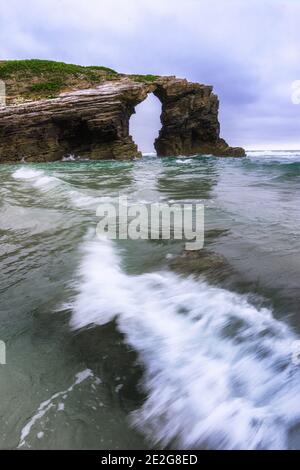Contenidos
Platja de les catedrals
rhodes beach
In Galicia, when the power of the sea and the patience of time come together, the result is a work of art… the beach of As Catedrais, a natural monument with a supernatural dimension. Just wait for the low tide, take off your shoes, start walking… and you feel in glory.
Nothing like enjoying the view of the 30 m high flying buttresses, discovering unusual perspectives of arches within arches. Or simply let yourself be carried along the sandy corridors between slate walls, as in an imposing and capricious central nave. And always, feet in the sand and head in the sky. We are in the cathedral of the sea.
Each visit is different. The sea always erases the previous traces, but the succession of monumental arches remains. In addition, the protected area within the Natura 2000 Network reaches a coastal stretch of about fifteen kilometers long in which we can find other beautiful sandy beaches such as Os Castros and the picturesque port of Rinlo.
During the summer months (from July 1 to September 30) and at Easter it is necessary to request a permit. This is free of charge and can be obtained online at https://ascatedrais.xunta.es.
wikipedia
Thus, if you are going to visit it, it is essential to know what is the tide schedule on the beach of the Cathedrals, because only coinciding with the low tides you can go down to the foot of the cliffs to walk along the sandy beach and next to the cathedrals.
For this reason, since a few summers ago the Xunta de Galicia has established limits for access to this natural monument of the Lucerne coast, which apply in these times of high tourist influx.
For your trip, book your rental car now, a website that offers you the best price guarantee and allows you a possible free cancellation in most cases, here you can book your car.
When you access this page, you must fill out a form with your details, and I anticipate that you can only make the reservation with a maximum of one month in advance of the date of your visit.
The information in this table will allow you to know at what time the low tide occurs on the beach of the Cathedrals during the day planned for your visit, so you can make your reservation at the most appropriate time.
cathedral beach spain map
In Galicia, when the power of the sea and the patience of time come together, the result is a work of art… the beach of As Catedrais, a natural monument with a supernatural dimension. Just wait for the low tide, take off your shoes, start walking… and you feel in glory.
Nothing like enjoying the view of the 30 m high flying buttresses, discovering unusual perspectives of arches within arches. Or simply let yourself be carried along the sandy corridors between slate walls, as in an imposing and capricious central nave. And always, feet in the sand and head in the sky. We are in the cathedral of the sea.
Each visit is different. The sea always erases the previous traces, but the succession of monumental arches remains. In addition, the protected area within the Natura 2000 Network reaches a coastal stretch of about fifteen kilometers long in which we can find other beautiful sandy beaches such as Os Castros and the picturesque port of Rinlo.
During the summer months (from July 1 to September 30) and at Easter it is necessary to request a permit. This is free of charge and can be obtained online at https://ascatedrais.xunta.es.
playa de gulpiyuribeach en españa
Este artículo incluye una lista de referencias, lecturas relacionadas o enlaces externos, pero sus fuentes no están claras porque carece de citas en línea. Por favor, ayude a mejorar este artículo introduciendo citas más precisas. (Septiembre de 2014) (Aprende cómo y cuándo eliminar este mensaje de la plantilla)
La Praia das Catedrais (español: playa de las Catedrales, inglés: Beach of the Cathedrals) se encuentra en la costa noroeste de España. Es el nombre dado por la industria turística a la Praia de Augas Santas (traducido del gallego: “Playa de las Aguas Santas”). La playa está situada en el municipio de Ribadeo, en la provincia de Lugo (Galicia), en la costa cantábrica, y se encuentra a unos diez kilómetros al oeste de la ciudad de Ribadeo. Su nombre deriva de sus formaciones acantiladas.
Los rasgos característicos de la playa son sus arcos y cuevas naturales, que sólo pueden verse con la marea baja. Durante la marea alta, la playa parece pequeña, pero sigue siendo apta para el baño. Durante la marea baja es más evidente el tamaño de sus acantilados y cuevas marinas, que van desde pequeñas grietas en la roca hasta grandes cuevas cuyos techos se han derrumbado debido a la erosión de las olas.
